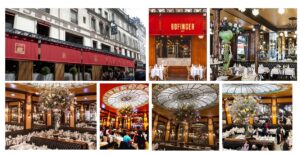While living in San Francisco some years back, I was a regular patron of a hole-in-the wall Punjabi restaurant in the Tenderloin district that served tasty Indian food for bargain-basement prices. Was it the best food ever? Of course not? But how can you argue with $1 naan?
Who cares if there were cigarette burns on the table cloth and the bathrooms were “less than pristine?” The food was yummy and it was a bargain!
Similarly, during my time as an English teacher in Shimonoseki, Japan, I was so proud of myself upon discovering a restaurant that piled a stack of tempura right onto my plate, willy nilly, without much care to the “plating,” at a ridiculously low price. Interestingly, I shared this place with a Japanese friend of mine and she said, “No way I could eat there. My food needs to be artistically presented or I can’t eat it!” Me, I couldn’t have cared less. “Tasty-and-cheap” was my motto.
In other words, given a choice, I almost always chose food over ambiance.
And then came Bofinger, a restaurant that flipped my thinking.

Founded in 1864 near the Place Bastille by Frederic Bofinger, a refugee from Alsace, “Bofinger” was the first brasserie in Paris; it also introduced Parisians to draft beer.
It is, quite simply, one of the most beautiful restaurants I’ve ever been to!
You see, in 1919, Bofinger was refurbished in the stunning Belle Epoch style. The gorgeous Art Nouveau domed glass ceiling, elaborate ironworks, and beveled mirrors today are much as they were over 100 years ago. Walking into the restaurant is like stepping onto a movie set. It’s the Great Gatsby come to life.
(Side note: In France, you can’t call everything a “restaurant.” A French “café” offers coffee and a small menu of snacks. A “bistro” serves a limited menu of home-style meals. A “brasserie” offers a much more extensive menu and traditionally has a connection with beer. Bofinger is most definitely a “brasserie.”
Is the food good at Bofinger? Yeah, it’s okay. Known for its traditional Alsatian food, the brasserie serves up a mean plate of sauerkraut. You can find flammekueche and vol au vent on their menu, along with a large seafood bar and an assortment of French classics. I remember the escargot was pretty decent, along with the mussels.
But honestly speaking, you don’t dine at Bofinger for the cuisine. You go there for the architecture: the intricate woodwork, the stained glass ceilings, the ornate mirrors. Heck, the place is a protected national monument!
Visiting Bofinger was a big shift for me. As mentioned, in my youth, ambiance meant little to me – I just wanted cheap vittles. Bofinger enlightened me, introducing the notion that the beauty of the setting can be just as delightful as the items on my plate.
But not too often. Bofinger is rather expensive. No $1 naan on their menu, alas.
(One of the hardest things to do in life is to change your values, which get laid down by the time you’re about 10 years old. I grew up in a frugal family, one that consistently transmitted the message, “We’re not rich, you know! When in doubt, choose cheap over luxury. You never know when your fortunes might turn and you’ll be out on the street.” Our society celebrates people who “stand up for their values,” even if those values often come from our friends and families…inherited during our conflicted, traumatized childhoods. What right, I wonder, do I have to impose my childhood values on your childhood values? What makes my family’s worldview better than yours?!! The answer is, nothing at all. That’s why I think we need to choose our values, as adults, with our fully-developed frontal cortexes. We need to base our beliefs and behaviors on love, compassion, empathy and service, on what benefits the many rather than the few. Reprogramming your values is hard, but it’s a necessary task for citizens interested in a peaceful, prosperous and caring world.)
(Dave Blum is the creator of Dr. Clue Treasure Hunts, www.drclue.com, a teambuilding company featuring over 150 treasure hunt locations worldwide. He has visited over 40 countries in his 60+ years of life and plans to keep traveling until he gives up the ghost. Dave lives in Northern California with his wife, Donica, and their 18-year-old Maine Coon, Ava — an indoor cat who dreams of one day escaping captivity and exploring her own neighborhood Wow Places.)
